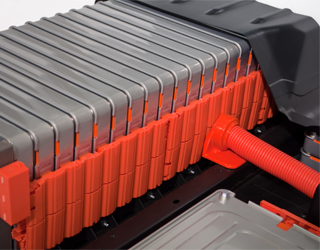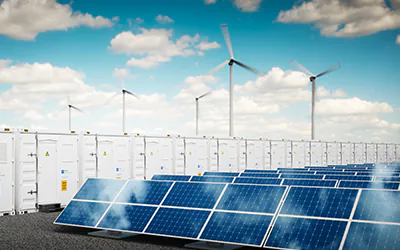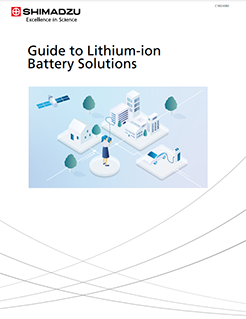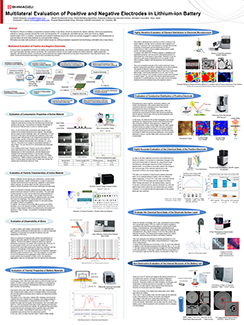Mesure de la Distribution de Taille des Particules des Matériaux de Batterie Lithium-Ion
Test et inspection des batteries et des piles à combustible
Test, analyse et inspection des batteries et des piles à combustible

Les progrès réalisés dans le domaine des piles à combustible et des batteries permettent de créer de nombreux véhicules électriques. Shimadzu fabrique une gamme complète d'instruments permettant de caractériser la composition et le comportement thermique/mécanique des membranes, des électrolytes et des électrodes des cellules de batterie.
Les scanners Shimadzu SMX-225CT permettent une imagerie non destructive précise des composants internes de la batterie.
Kratos Analytical , filiale de Shimadzu, propose des instruments de spectroscopie photoélectronique à rayons X pour des études de surface et électrochimiques avancées.
Guide des solutions de batteries lithium-ion
Solutions pour les tests de matériaux, l'analyse thermique, l'analyse des composants organiques/inorganiques, l'évaluation de la structure interne, la microanalyse et la caractérisation des particules des batteries lithium-ion.
Évaluation multilatérale des électrodes positives et négatives dans les batteries lithium-ion
La demande de batteries lithium-ion devrait encore augmenter à l'avenir, stimulée par la demande de véhicules électriques, qui est soutenue par les politiques de divers pays du monde, et par la demande d'ordinateurs, de smartphones et de tablettes, qui est stimulée par la transformation numérique (DX). En outre, des entreprises et des instituts de recherche du monde entier sont activement engagés dans la recherche et le développement pour commercialiser toutes les batteries à semi-conducteurs en tant que batteries de nouvelle génération. Shimadzu fournit des solutions complètes à divers problèmes du marché en utilisant des équipements d'évaluation et une technologie cultivée au cours d'une longue histoire.
Matrice d'instruments de test de batteries rechargeables au lithium-ion
| Partie | Matériau | Composants Couramment Utilisés | Articles de Test (Instrument) |
|---|---|---|---|
| Électrode Positive | Matériau Actif | LiCoO2 (oxyde de cobalt de lithium) Mn ou Ni peut être utilisé à la place de Co. |
Composition (ICPES,XRF) Crystallinité (XRD) Taille de Particule (Analyse de la Taille des Particules) État des Électrons (XPS) |
| Liant | Fluorure de vinylidène (polyfluorure de vinyle (PVDF)) | Distribution de poids moléculaire (GPC), Composition (FTIR) | |
| Améliorateur de Conductivité | Carbone (noir de carbone, noir d'acétylène, graphite, etc) | Crystallinité (XRD) | |
| Électrode Négative | Matériau Actif | Carbone, graphite | Crystallinité (XRD), Taille de Particule (Analyse de la Taille des Particules) |
| Additif Trace | Li, P, Cu, Na, Co, Ca, K, etc | Composition (ICP) | |
| Liant | SBR CMC (carboxyméthylcellulose), PVDF également utilisé précédemment |
Structure (FTIR) | |
| Séparateur | Polyoléfines (polyéthylène haute densité) | Structure (FTIR) Caractéristiques thermiques (TGA) |
|
| Solution Électrolytique | Solvant | Esther de carbonate, esther de carboxylate, éther | Composition (GCMS,GC) |
| Électrolyte | LiPF6, LiBF4 | Composition (ICP) | |
| Additif | Carbonate de vinyle | Composition (GCMS) | |
| Cellule unique, module | Résistance à la compression (Machine d'essai universelle) | ||
Applications

Électrode Positive
L'électrode positive est un composant important qui influence la performance de la batterie lithium-ion. Le développement de matériaux est en cours pour améliorer la densité énergétique élevée et la durabilité contre les cycles de charge/décharge. Afin de réduire le coût de la batterie et garantir un approvisionnement stable, l'approvisionnement en matériaux actifs pour électrodes positives sans cobalt est en cours d'avancement.
Applications
-
Propriétés des Particules (SALD)
-
Cartographie Élémentaire (EPMA)
-
Analyse d'État (EPMA)
-
Analyse de Cartographie Élément et Actuelle (EPMA, SPM)
-
Exposition à l'Air de l'Anode et de la Cathode (SPM ou AFM)

Électrode Négative
À mesure que le marché des batteries lithium-ion pour l'automobile s'étend, le défi est de renforcer la densité énergétique tout en réduisant les coûts. En tant que composant, l'électrode négative joue un rôle important aux côtés de l'électrode positive.
Applications Présentées
Revêtements/Films Automobiles
Batteries et Piles à Hydrogène
Composites
Essai Mécanique Haute Vitesse et Imagerie
Analyse des Lubrifiants
Contrôle de Qualité / Assurance Qualité

Séparateur
Le séparateur est un composant important qui empêche les courts-circuits entre les électrodes positives et négatives, et facilite en même temps le passage fluide des ions lithium. En plus d'une grande sécurité, une haute densité énergétique, une haute entrée/sortie et un faible coût sont requis, et il est important d'évaluer la performance sous divers angles.

Séparateur
Le séparateur est un composant important qui empêche les courts-circuits entre les électrodes positives et négatives, et facilite en même temps le passage fluide des ions lithium. En plus d'une grande sécurité, une haute densité énergétique, une haute entrée/sortie et un faible coût sont requis, et il est important d'évaluer la performance sous divers angles.

Solution Électrolytique
Les électrolytes et les solvants qui composent la solution électrolytique doivent avoir des caractéristiques telles que la résistance à l'oxydation et à la réduction pendant la charge et la décharge, la stabilité thermique et chimique, ainsi que la conductivité ionique, et doivent être capables de produire des revêtements SEI de haute qualité. Il est également important d'analyser les composants de la solution électrolytique afin d'évaluer la performance de la batterie, car la composition est modifiée par la réaction de la batterie.

Solution Électrolytique
Les électrolytes et les solvants qui composent la solution électrolytique doivent avoir des caractéristiques telles que la résistance à l'oxydation et à la réduction pendant la charge et la décharge, la stabilité thermique et chimique, ainsi que la conductivité ionique, et doivent être capables de produire des revêtements SEI de haute qualité. Il est également important d'analyser les composants de la solution électrolytique afin d'évaluer la performance de la batterie, car la composition est modifiée par la réaction de la batterie.

Cellule de Batterie
Les batteries lithium-ion sont utilisées dans divers domaines et applications, et il est important d'analyser les produits défectueux, de comparer les bons produits et les produits défectueux, de comparer avant et après la charge et la décharge, d'observer les changements structurels à l'intérieur des cellules lors des essais de cycle, et d'évaluer les composants gazeux.

Analyse des Gaz Internes (GCMS)
Analyse des Gaz Émis par les Cellules de Batteries Lithium-Ion Rechargeables.
-
Système d'Analyse pour les Gaz Internes (GC)
Revues & Articles
Étude expérimentale sur la formabilité des sachets en aluminium pour batteries au lithium polymère par les procédés de fabrication
Yu, M., Song, M., Kim, M. et al. J Mech Sci Technol (2019) 33: 4353. https://doi.org/10.1007/s12206-019-0831-y




